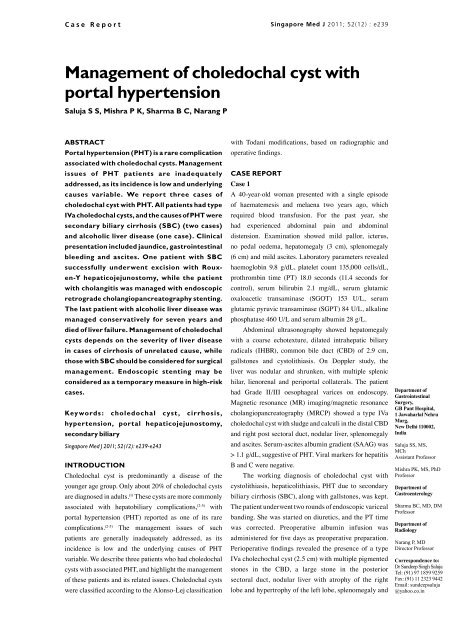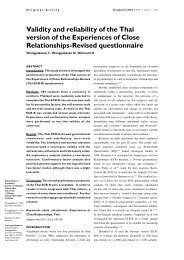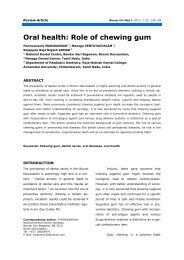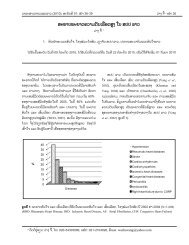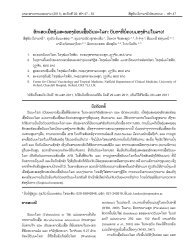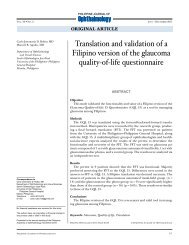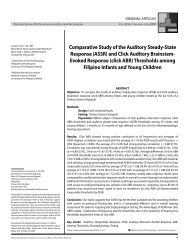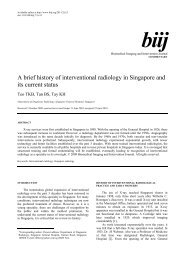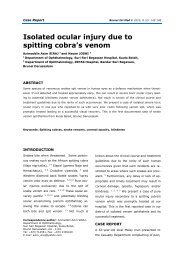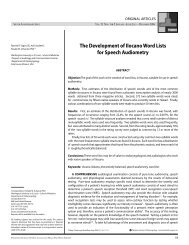Management of choledochal cyst with portal ... - APAMED Central
Management of choledochal cyst with portal ... - APAMED Central
Management of choledochal cyst with portal ... - APAMED Central
You also want an ePaper? Increase the reach of your titles
YUMPU automatically turns print PDFs into web optimized ePapers that Google loves.
Case Report<br />
Singapore Med J 2011; 52(12) : e239<br />
<strong>Management</strong> <strong>of</strong> <strong>choledochal</strong> <strong>cyst</strong> <strong>with</strong><br />
<strong>portal</strong> hypertension<br />
Saluja S S, Mishra P K, Sharma B C, Narang P<br />
ABSTRACT<br />
Portal hypertension (PHT) is a rare complication<br />
associated <strong>with</strong> <strong>choledochal</strong> <strong>cyst</strong>s. <strong>Management</strong><br />
issues <strong>of</strong> PHT patients are inadequately<br />
addressed, as its incidence is low and underlying<br />
causes variable. We report three cases <strong>of</strong><br />
<strong>choledochal</strong> <strong>cyst</strong> <strong>with</strong> PHT. All patients had type<br />
IVa <strong>choledochal</strong> <strong>cyst</strong>s, and the causes <strong>of</strong> PHT were<br />
secondary biliary cirrhosis (SBC) (two cases)<br />
and alcoholic liver disease (one case). Clinical<br />
presentation included jaundice, gastrointestinal<br />
bleeding and ascites. One patient <strong>with</strong> SBC<br />
successfully underwent excision <strong>with</strong> Rouxen-Y<br />
hepaticojejunostomy, while the patient<br />
<strong>with</strong> cholangitis was managed <strong>with</strong> endoscopic<br />
retrograde cholangiopancreatography stenting.<br />
The last patient <strong>with</strong> alcoholic liver disease was<br />
managed conservatively for seven years and<br />
died <strong>of</strong> liver failure. <strong>Management</strong> <strong>of</strong> <strong>choledochal</strong><br />
<strong>cyst</strong>s depends on the severity <strong>of</strong> liver disease<br />
in cases <strong>of</strong> cirrhosis <strong>of</strong> unrelated cause, while<br />
those <strong>with</strong> SBC should be considered for surgical<br />
management. Endoscopic stenting may be<br />
considered as a temporary measure in high-risk<br />
cases.<br />
Keywords: <strong>choledochal</strong> <strong>cyst</strong>, cirrhosis,<br />
hypertension, <strong>portal</strong> hepaticojejunostomy,<br />
secondary biliary<br />
Singapore Med J 2011; 52(12): e239-e243<br />
INTROduCTION<br />
Choledochal <strong>cyst</strong> is predominantly a disease <strong>of</strong> the<br />
younger age group. Only about 20% <strong>of</strong> <strong>choledochal</strong> <strong>cyst</strong>s<br />
are diagnosed in adults. (1) These <strong>cyst</strong>s are more commonly<br />
associated <strong>with</strong> hepatobiliary complications, (2-5) <strong>with</strong><br />
<strong>portal</strong> hypertension (PHT) reported as one <strong>of</strong> its rare<br />
complications. (2-5) The management issues <strong>of</strong> such<br />
patients are generally inadequately addressed, as its<br />
incidence is low and the underlying causes <strong>of</strong> PHT<br />
variable. We describe three patients who had <strong>choledochal</strong><br />
<strong>cyst</strong>s <strong>with</strong> associated PHT, and highlight the management<br />
<strong>of</strong> these patients and its related issues. Choledochal <strong>cyst</strong>s<br />
were classified according to the Alonso-Lej classification<br />
<strong>with</strong> Todani modifications, based on radiographic and<br />
operative findings.<br />
CASE REPORT<br />
Case 1<br />
A 40-year-old woman presented <strong>with</strong> a single episode<br />
<strong>of</strong> haematemesis and melaena two years ago, which<br />
required blood transfusion. For the past year, she<br />
had experienced abdominal pain and abdominal<br />
distension. Examination showed mild pallor, icterus,<br />
no pedal oedema, hepatomegaly (3 cm), splenomegaly<br />
(6 cm) and mild ascites. Laboratory parameters revealed<br />
haemoglobin 9.8 g/dL, platelet count 135,000 cells/dL,<br />
prothrombin time (PT) 18.0 seconds (11.4 seconds for<br />
control), serum bilirubin 2.1 mg/dL, serum glutamic<br />
oxaloacetic transaminase (SGOT) 153 U/L, serum<br />
glutamic pyruvic transaminase (SGPT) 84 U/L, alkaline<br />
phosphatase 460 U/L and serum albumin 28 g/L.<br />
Abdominal ultrasonography showed hepatomegaly<br />
<strong>with</strong> a coarse echotexture, dilated intrahepatic biliary<br />
radicals (IHBR), common bile duct (CBD) <strong>of</strong> 2.9 cm,<br />
gallstones and <strong>cyst</strong>olithiasis. On Doppler study, the<br />
liver was nodular and shrunken, <strong>with</strong> multiple splenic<br />
hilar, lienorenal and peri<strong>portal</strong> collaterals. The patient<br />
had Grade II/III oesophageal varices on endoscopy.<br />
Magnetic resonance (MR) imaging/magnetic resonance<br />
cholangiopancreatography (MRCP) showed a type IVa<br />
<strong>choledochal</strong> <strong>cyst</strong> <strong>with</strong> sludge and calculi in the distal CBD<br />
and right post sectoral duct, nodular liver, splenomegaly<br />
and ascites. Serum-ascites albumin gradient (SAAG) was<br />
> 1.1 g/dL, suggestive <strong>of</strong> PHT. Viral markers for hepatitis<br />
B and C were negative.<br />
The working diagnosis <strong>of</strong> <strong>choledochal</strong> <strong>cyst</strong> <strong>with</strong><br />
<strong>cyst</strong>olithiasis, hepaticolithiasis, PHT due to secondary<br />
biliary cirrhosis (SBC), along <strong>with</strong> gallstones, was kept.<br />
The patient underwent two rounds <strong>of</strong> endoscopic variceal<br />
banding. She was started on diuretics, and the PT time<br />
was corrected. Preoperative albumin infusion was<br />
administered for five days as preoperative preparation.<br />
Perioperative findings revealed the presence <strong>of</strong> a type<br />
IVa cholechochal <strong>cyst</strong> (2.5 cm) <strong>with</strong> multiple pigmented<br />
stones in the CBD, a large stone in the posterior<br />
sectoral duct, nodular liver <strong>with</strong> atrophy <strong>of</strong> the right<br />
lobe and hypertrophy <strong>of</strong> the left lobe, splenomegaly and<br />
Department <strong>of</strong><br />
Gastrointestinal<br />
Surgery,<br />
GB Pant Hospital,<br />
1 Jawaharlal Nehru<br />
Marg,<br />
New Delhi 110002,<br />
India<br />
Saluja SS, MS,<br />
MCh<br />
Assistant Pr<strong>of</strong>essor<br />
Mishra PK, MS, PhD<br />
Pr<strong>of</strong>essor<br />
Department <strong>of</strong><br />
Gastroenterology<br />
Sharma BC, MD, DM<br />
Pr<strong>of</strong>essor<br />
Department <strong>of</strong><br />
Radiology<br />
Narang P, MD<br />
Director Pr<strong>of</strong>essor<br />
Correspondence to:<br />
Dr Sundeep Singh Saluja<br />
Tel: (91) 97 1859 9259<br />
Fax: (91) 11 2323 9442<br />
Email: sundeepsaluja<br />
@yahoo.co.in
1a<br />
1b<br />
Fig. 1 Case 1. (a) Postoperative T2-W MR image shows right<br />
and left lobe hypertrophy, retained calculi in the right sectoral<br />
duct, splenomegaly and mild ascites. (b) Postoperative MRCP<br />
image shows hepaticojejunostomy, <strong>with</strong> mild intrahepatic biliary<br />
dilatation on the right side.<br />
multiple collaterals in the hepatoduodenal ligament and<br />
omentum.<br />
The patient underwent excision <strong>of</strong> the <strong>choledochal</strong><br />
<strong>cyst</strong> <strong>with</strong> Roux-en-Y hepaticojejunostomy. While<br />
retrieving the large intrahepatic stone, bleeding occurred<br />
and was managed conservatively, requiring two units <strong>of</strong><br />
blood. Postoperatively, her ascites increased despite being<br />
given diuretics, and she developed wound dehiscence<br />
on postoperative Day 9. The patient subsequently<br />
underwent secondary suturing. Operative biopsy showed<br />
fibrous tissue septa <strong>with</strong> periductular fibrosis, ductular<br />
proliferation and intraductular cholestasis, suggestive <strong>of</strong><br />
obstructive pathology as the cause <strong>of</strong> cirrhosis. At the<br />
one-year follow-up, the patient was well and the ascites<br />
were controlled <strong>with</strong> diuretics. MR imaging/MRCP<br />
showed a dilated right post sectoral duct <strong>with</strong> stone, a<br />
normal left system and hepaticojejunostomy (Fig. 1).<br />
Endoscopy showed Grade II varices.<br />
Case 2<br />
A 66-year-old man presented <strong>with</strong> complaints <strong>of</strong><br />
recurrent episodes <strong>of</strong> jaundice <strong>with</strong>out pruritus<br />
2a<br />
2b<br />
Singapore Med J 2011; 52(12) : e240<br />
Fig. 2 Case 2. (a) CT image shows an uncomplicated <strong>choledochal</strong><br />
<strong>cyst</strong> <strong>with</strong> multiple collaterals, patent <strong>portal</strong> vein and mild ascites.<br />
(b) MRCP image shows a type IVa <strong>choledochal</strong> <strong>cyst</strong> <strong>with</strong>out any<br />
stones and a normal pancreatic duct <strong>with</strong> mild ascites.<br />
or clay-coloured stool, which had been associated<br />
<strong>with</strong> abdominal distention since 2002. The patient<br />
was diagnosed <strong>with</strong> a <strong>choledochal</strong> <strong>cyst</strong> in 2003 and<br />
<strong>of</strong>fered surgical management for which he refused.<br />
He again developed jaundice for three months, which<br />
was accompanied <strong>with</strong> abdominal distension and an<br />
episode <strong>of</strong> melaena. He had been a chronic alcoholic<br />
for the past 50 years, consuming about 80–120 g <strong>of</strong><br />
alcoholic beverages per day. However, he had been<br />
abstaining from alcohol since the previous year. On<br />
examination, he had moderate icterus, gynaecomastia,<br />
hepatomegaly (6 cm) and moderate ascites. Laboratory
parameters revealed total/direct bilirubin 7.6/4.1 mg/<br />
dL, SGOT 145 U/L, SGPT 38 U/L, alkaline phosphatase<br />
207 U/L, total protein/albumin 74/28 g/L and PT 19<br />
seconds (14 seconds for control).<br />
Abdominal ultrasonography demonstrated<br />
hepatomegaly (16 cm) <strong>with</strong> a coarse echotexture and<br />
nodular surface, dilated IHBR <strong>with</strong> fusiform dilatation<br />
<strong>of</strong> the CBD (4 cm), <strong>portal</strong> cavernoma <strong>with</strong> ascites. SAAG<br />
was > 1.1 g/dL, suggestive <strong>of</strong> PHT. Endoscopy revealed<br />
Grade III/IV esophageal varices and normal papilla.<br />
MR imaging/MRCP confirmed the ultrasonographic<br />
findings <strong>of</strong> <strong>choledochal</strong> <strong>cyst</strong> type IVa <strong>with</strong> PHT (Fig. 2).<br />
Viral markers for hepatitis B and C as well as<br />
autoimmune markers were negative.<br />
The patient was managed conservatively for<br />
seven years, during which he had two episodes <strong>of</strong><br />
jaundice <strong>with</strong> ascites. Based on the working diagnosis<br />
<strong>of</strong> alcoholic liver disease <strong>with</strong> Child Class C cirrhosis<br />
and uncomplicated <strong>choledochal</strong> <strong>cyst</strong>, he was scheduled<br />
for primary prophylaxis <strong>of</strong> varices and endoscopic<br />
retrograde cholangiopancreatography (ERCP) stenting<br />
to assess and relieve the jaundice due to any obstructive<br />
component. Counselling regarding liver transplant was<br />
also scheduled. Unfortunately, the patient developed<br />
hepatic encephalopathy <strong>with</strong> hepatorenal syndrome<br />
before he could undergo ERCP, and subsequently died<br />
<strong>of</strong> liver failure.<br />
Case 3<br />
A 49-year-old known diabetic man presented <strong>with</strong><br />
jaundice that was associated <strong>with</strong> cholestatic symptoms<br />
and weight loss for three months. Examination revealed<br />
icterus, hepatomegaly (4 cm) and a palpable gallbladder.<br />
Laboratory parameters showed haemoglobin 12.9 g/dL,<br />
total bilirubin 12.5 mg/dL, SGOT 81 U/L, SGPT 56 U/L,<br />
alkaline phosphatase 528 U/L and albumin 32 g/L.<br />
Abdominal ultrasonography showed hepatomegaly<br />
<strong>with</strong> a coarse echotexture and nodular surface as well<br />
as a type IVa <strong>choledochal</strong> <strong>cyst</strong> <strong>with</strong> multiple calculi.<br />
Doppler study revealed <strong>portal</strong> vein (13.5 mm) <strong>with</strong><br />
multiple collaterals at the splenic hilum. Endoscopy<br />
revealed Grade II varices and normal papilla. MRCP<br />
confirmed the ultrasonographic findings.<br />
The working diagnosis <strong>of</strong> <strong>choledochal</strong> <strong>cyst</strong> <strong>with</strong><br />
<strong>cyst</strong>olithiasis, jaundice and PHT was kept. The patient<br />
was originally scheduled for stone removal <strong>with</strong> ERCP<br />
but underwent stenting instead, as a large stone could<br />
not be removed. Two months later, he underwent<br />
repeat ERCP, and multiple stones were removed after<br />
lithotripsy. Three months later, the patient was readmitted<br />
due to cholangitis <strong>with</strong> renal failure. He was<br />
Singapore Med J 2011; 52(12) : e241<br />
started on intravenous fluids and antibiotics, and stent<br />
change was planned. Despite the stent change and<br />
endoscopic nasobiliary drain placement, the patient<br />
died from sepsis nine months after his diagnosis.<br />
dISCuSSION<br />
Choledochal <strong>cyst</strong> is a surgical problem typically related<br />
to infancy and childhood. (1) The incidence <strong>of</strong> diagnosis<br />
in adulthood is increasing <strong>with</strong> advances in imaging<br />
techniques. In contrast to children, <strong>choledochal</strong> <strong>cyst</strong>s in<br />
adults are associated <strong>with</strong> a higher incidence <strong>of</strong> <strong>cyst</strong>related<br />
complications. These include <strong>cyst</strong>olithiasis,<br />
hepaticolithiasis, calculous chole<strong>cyst</strong>itis pancreatitis,<br />
maliganancy and cirrhosis <strong>with</strong> PHT. (2-5) PHT is a<br />
rare condition that complicates the management <strong>of</strong><br />
<strong>choledochal</strong> <strong>cyst</strong>s, especially when diagnosed in the<br />
fifth or sixth decade <strong>of</strong> life. It manifests clinically in the<br />
form <strong>of</strong> hepatosplenomegaly, jaundice, haematemesis,<br />
melaena or ascites.<br />
The various causes <strong>of</strong> PHT include extrahepatic<br />
biliary obstruction leading to SBC, recurrent<br />
inflammation leading to <strong>portal</strong> vein thrombosis, direct<br />
compression <strong>of</strong> the <strong>portal</strong> vein, (6) and other unrelated<br />
aetiologies <strong>of</strong> cirrhosis. The mechanism responsible<br />
for development <strong>of</strong> PHT determines whether surgical<br />
intervention may be beneficial. Direct compression <strong>of</strong><br />
the <strong>portal</strong> vein is reported as the main mechanism in<br />
children. Surgical decompression <strong>of</strong> the <strong>cyst</strong> by internal<br />
drainage has been shown to reverse PHT in these<br />
patients. (6)<br />
Portal vein thrombosis may be suspected in patients<br />
who have a history <strong>of</strong> recurrent cholangitis. In these cases,<br />
the <strong>cyst</strong> may be densely adherent to the <strong>portal</strong> vein. It can<br />
be diagnosed on preoperative Doppler ultrasonography.<br />
Modified <strong>cyst</strong> resection, leaving behind the posterior<br />
wall <strong>of</strong> the <strong>cyst</strong> that is adherent to the <strong>portal</strong> vein, <strong>with</strong><br />
cauterisation <strong>of</strong> the mucosa, can be employed in these<br />
patients.<br />
SBC and unrelated cirrhosis are the main<br />
mechanisms responsible for the development <strong>of</strong> PHT in<br />
adults. In our series, two had SBC and one had alcoholic<br />
liver disease as the causes <strong>of</strong> PHT. In adults, PHT due<br />
to SBC should be differentiated from that <strong>with</strong> unrelated<br />
causes, as the management differs in the two situations.<br />
Since surgical treatment in the presence <strong>of</strong> PHT is<br />
associated <strong>with</strong> increased morbidity and mortality, (7)<br />
patients <strong>with</strong> no evidence <strong>of</strong> obstruction and definitive<br />
evidence <strong>of</strong> cirrhosis due to other causes can be managed<br />
conservatively. One reason for surgery in uncomplicated<br />
<strong>cyst</strong> is the increased risk <strong>of</strong> hepatobiliary malignancy; this<br />
may not be significant, especially when an uncomplicated
Child A/B<br />
Excision &<br />
RYHJ<br />
Secondary<br />
biliary cirrhosis<br />
Stent<br />
Child C<br />
Child A/B<br />
Choledochal <strong>cyst</strong> <strong>with</strong><br />
<strong>portal</strong> hypertension<br />
Child C<br />
Transplant Excision &<br />
RYHJ<br />
Stent<br />
Transplant<br />
Successful<br />
Shunt<br />
Cirrhosis -<br />
unrelated cause<br />
Unsuccessful<br />
Stent<br />
Fig. 3 Algorithm for management <strong>of</strong> <strong>choledochal</strong> <strong>cyst</strong> <strong>with</strong> <strong>portal</strong> hypertension.<br />
<strong>cyst</strong> is detected in the fifth or sixth decade <strong>of</strong> life. Case 2<br />
was managed conservatively for seven years after the<br />
diagnosis <strong>of</strong> uncomplicated <strong>cyst</strong> <strong>with</strong> alcoholic liver<br />
disease was made, but he eventually succumbed to liver<br />
failure.<br />
<strong>Management</strong> <strong>of</strong> <strong>choledochal</strong> <strong>cyst</strong> <strong>with</strong> SBC<br />
would depend on the Child Class, the presence <strong>of</strong><br />
<strong>portal</strong> vein thrombosis and amount <strong>of</strong> collaterals<br />
around the <strong>cyst</strong>. Decompression <strong>of</strong> the <strong>cyst</strong> prevents<br />
further deterioration <strong>of</strong> liver function, and may even<br />
improve or completely reverse cirrhotic changes. (8)<br />
Surgical decompression appears to be more<br />
effective than endoscopic stenting, as observed in<br />
our patients. Endoscopic drainage may serve as a<br />
temporary measure in patients who are unfit for<br />
surgery. (9) Prolonged endoscopic drainage may be<br />
associated <strong>with</strong> complications like stent blockage,<br />
and may require stent change, as seen in Case 3.<br />
Therefore, patients may be considered for definitive<br />
surgical treatment once endoscopic stenting has<br />
improved the liver function and reduced the surgical<br />
risk in these patients. (9)<br />
Although decompression by Roux-en-Y drainage<br />
can result in adequate long-term functional improvement<br />
Observe<br />
Singapore Med J 2011; 52(12) : e242<br />
in 60%–70% <strong>of</strong> cases, excision and hepaticojejunostomy<br />
is the treatment <strong>of</strong> choice. (10) Surgical treatment requires<br />
preoperative preparation, including correction <strong>of</strong> the<br />
coagulation status, improvement <strong>of</strong> albumin level, and<br />
control <strong>of</strong> ascites and varices. Portal decompression may<br />
be required before biliary reconstruction, (2) especially in<br />
the presence <strong>of</strong> <strong>portal</strong> vein thrombosis and collaterals<br />
along the hepatoduodenal ligament. On the other hand, a<br />
shunt may cause further deterioriation <strong>of</strong> liver function<br />
by diverting the <strong>portal</strong> flow, especially in patients <strong>with</strong><br />
Child Class C status. Liver transplantation should be<br />
<strong>of</strong>fered to patients <strong>with</strong> Child Class C cirrhosis. In the<br />
absence <strong>of</strong> <strong>portal</strong> vein thrombosis, careful ligation <strong>of</strong><br />
the collaterals may enable the surgical procedure to be<br />
completed. (11)<br />
Portal vein<br />
thrombosis<br />
Complicated Uncomplicated Excision & RYHJ<br />
Successful<br />
Unsuccessful<br />
Shunt<br />
RYHJ: Roux-en-Y hepaticojejunostomy<br />
In the presence <strong>of</strong> partial thrombosis <strong>with</strong> Child<br />
Class A/B cirrhosis, excision <strong>of</strong> the <strong>choledochal</strong> <strong>cyst</strong><br />
may be attempted first, <strong>with</strong> the shunt kept as reserve<br />
option in the event that access to the hepatoduodenal<br />
ligament is not possible as planned, as was the case<br />
in our first patient. Choledochal <strong>cyst</strong> <strong>with</strong> PHT is<br />
rarely encountered. Although it is not possible to draw<br />
conclusions from a small series <strong>of</strong> <strong>choledochal</strong> <strong>cyst</strong> <strong>with</strong><br />
PHT, we had followed up our cases for long periods
and reviewed other reports in the literature in order<br />
to suggest an algorithm for the management <strong>of</strong> such<br />
patients (Fig. 3).<br />
In adults, the cause <strong>of</strong> PHT in <strong>choledochal</strong> <strong>cyst</strong><br />
guides the management <strong>of</strong> the disease. Surgical<br />
management <strong>with</strong> adequate preoperative preparation<br />
should be considered for patients <strong>with</strong> <strong>choledochal</strong><br />
<strong>cyst</strong> and SBC. ERCP and stenting may be considered<br />
as temporary measures in high-risk cases. In cases<br />
where there is an unrelated cause <strong>of</strong> cirrhosis <strong>with</strong> an<br />
uncomplicated <strong>cyst</strong>, management should be based on the<br />
extent <strong>of</strong> liver disease.<br />
REFERENCES<br />
1. Flanigan DP. Biliary <strong>cyst</strong>s. Ann Surg 1975; 182:635-43.<br />
2. Nagorney DM, McIlrath DC, Adson MA. Choledochal Cyst in<br />
adults: clinical management. Surgery 1984; 96:656-63.<br />
3. Gigot J, Nagorney DM, Farnell M, Moir C, Ilstrup D. Bile duct<br />
<strong>cyst</strong>s: a changing spectrum <strong>of</strong> disease. J Hepatobiliary Pancreat<br />
Singapore Med J 2011; 52(12) : e243<br />
Surg 1996; 3:405-11.<br />
4. Lenriot JP, Gigot JF, Ségol P, et al. Bile duct <strong>cyst</strong>s in adults: a<br />
multi-institutional retrospective study. French Associations <strong>of</strong><br />
Surgical Research. Ann Surg 1998; 228:159-66.<br />
5. Lipsett PA, Pitt HA, Colombani PM, Boitnott JK, Cameron JL.<br />
Choledochal <strong>cyst</strong> disease. A changing pattern <strong>of</strong> presentation.<br />
Ann Surg 1994; 220:644-52.<br />
6. Martin LW, Rowe GA. Portal hypertension secondary to<br />
<strong>choledochal</strong> <strong>cyst</strong>. Am J Surg 1979; 190:638-9.<br />
7. Lal R, Agarwal S, Shivhare R, et al. <strong>Management</strong> <strong>of</strong> complicated<br />
<strong>choledochal</strong> <strong>cyst</strong>s. Dig Surg 2007; 24:456-62.<br />
8. Yeong ML, Nicholson GI, Lee SP. Regression <strong>of</strong> biliary cirrhosis<br />
following <strong>choledochal</strong> <strong>cyst</strong> drainage. Gastroenterology 1982;<br />
82:332-5.<br />
9. Rao KL, Chowdhary SK, Kumar D. Choledochal <strong>cyst</strong> associated<br />
<strong>with</strong> <strong>portal</strong> hypertension. Pediatr Surg Int 2003; 19:729-32.<br />
10. Kim SH. Choledochal <strong>cyst</strong>: survey by the surgical section<br />
<strong>of</strong> the American Academy <strong>of</strong> Pediatrics. J Pediatr Surg 1981;<br />
16:402-7.<br />
11. Singh S, Kheria LS, Puri S, Puri AS, Agarwal AK. Choledochal<br />
<strong>cyst</strong> <strong>with</strong> large stone cast and <strong>portal</strong> hypertension. Hepatobiliary<br />
Pancreat Dis Int 2009; 8:647-9.


